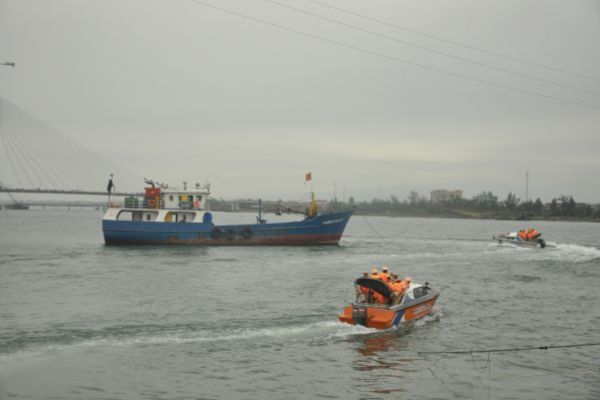Procedure for Conducting the Latest Control of Waterway Transport Vehicles
How should the Waterway Police choose a control position when stopping waterway vehicles?
Pursuant to the provisions of Clause 2, Article 8 of Circular 36/2023/TT-BCA as follows:
Stopping vehicles for control
..
2. Requirements when stopping vehicles for control
a) Safe, conformable with the law, not obstructing traffic activities. Once the vehicle is stopped, conduct the control and handle violations (if any) according to law;
b) Choose a control position with deep, wide, and clear visibility; ensure the stopping and control of vehicles is public and transparent;
c) In the case of stopping the control of vehicles transporting inflammable, explosive, toxic substances, or other dangerous goods, in addition to meeting the requirements at points a and b of this clause, it is necessary to have safety measures to guide the vehicle away from residential areas or sparsely populated places to stop, and then proceed with control.
...
Thus, according to the aforementioned regulations, when the Waterway Police stop waterway vehicles for control, they must choose a control position with deep, wide, clear visibility, ensuring the stopping and control of vehicles is public and transparent.

The newest process of controlling waterway traffic vehicles (Image from the Internet)
How is the process of controlling waterway traffic vehicles carried out?
Pursuant to the provisions of Clause 1, Article 9 of Circular 36/2023/TT-BCA, the process of controlling waterway traffic vehicles is regulated as follows:
- After issuing a stop signal for the vehicle, officers of the Patrol and Control Team guide the vehicle to the shore or dock (if checking at the Station) or alongside the patrol and control vehicle.
In cases where the stop position of the vehicle being checked has deep water, complex terrain, narrow, shallow, or the vehicle has difficulty stopping, inform the vehicle operator to reduce speed and maneuver the patrol and control vehicle alongside the vehicle to be controlled;
- The team leader and assigned members board the vehicle, meet the vehicle owner or operator, and depending on specific cases, the team leader or assigned members can perform the greeting gesture as per the Police Code or verbally greet, introduce their rank, name, position, work unit; inform the reason, content of control, and request compliance; conduct control according to regulations;
- Control content and methods on the vehicle:
+ Check vehicle documents, crew members, and passengers; check the cargo on the vehicle, cargo documents, and other relevant documents as per regulations (hereinafter referred to as documents). When checking documents, it is necessary to compare with the actual situation and determine the legality of the documents;
+ Check the technical safety and environmental protection conditions of the vehicle: Check by observation, compare with the actual vehicle documents, or by technical devices in the order from inside to outside, from top to bottom. When necessary, check on the data system or request expert assessment;
+ Check transportation safety: The vehicle's draft compared to the safe draft mark; type, volume, quantity, specifications, cargo dimensions, objects, actual number of people compared to the vehicle's carrying capacity and safety measures in transportation activities;
+ Check other relevant content as per legal regulations;
During control, the presence of the vehicle owner, crew members, or operator is required. In the absence of these individuals, control must have the presence of local government representatives or at least one witness.
Once national databases, specialized databases are connected with the e-identification and authentication system, obtaining information about the validity, usability of the mentioned documents (temporary hold, suspension of use, revocation, confiscation, loss), control through checking, comparing information of those documents in the level 2 e-identification account is as valid as checking the physical documents directly.
- In case the vehicle operator presents documents, directly check and compare those documents.
In case the vehicle operator provides information of the documents in the e-identification account, check and compare the information of those documents in the e-identification account.
During control, if detecting the e-identification account shows signs of forgery, or the organization or individual commits violations requiring temporary hold, suspension, revocation, confiscation of documents, request the individual or organization to present those documents to handle according to the law;
- In case of controlling vehicles transporting inflammable, explosive, toxic substances, or other dangerous goods, safety measures must be taken to guide the vehicle away from residential areas or sparsely populated places to conduct control; if necessary, request the participation of specialized agencies in the inspection activities.
Are Waterway Police allowed to temporarily hold the documents of violators?
Pursuant to the provisions of Clause 1, Article 10 of Circular 36/2023/TT-BCA, when detecting violations subject to penalties without a report, the authorized person must issue an administrative penalty decision on the spot.
In cases where the individual or organization violates but does not immediately comply with the penalty decision, they have the right to temporarily hold related documents in the following order:
- Master’s competency certificate,
- Vehicle driving license,
- Vehicle registration certificate or valid confirmation from the credit institution in case of vehicle mortgage,
- Vehicle's technical safety and environmental protection certificate,
- Chief engineer’s competency certificate,
- Other documents related to the evidence and vehicle as per regulations to ensure compliance with the administrative penalty decision.
If the violator does not have the above documents, the offending vehicle can be temporarily held to ensure the implementation of the administrative penalty decision.
LawNet